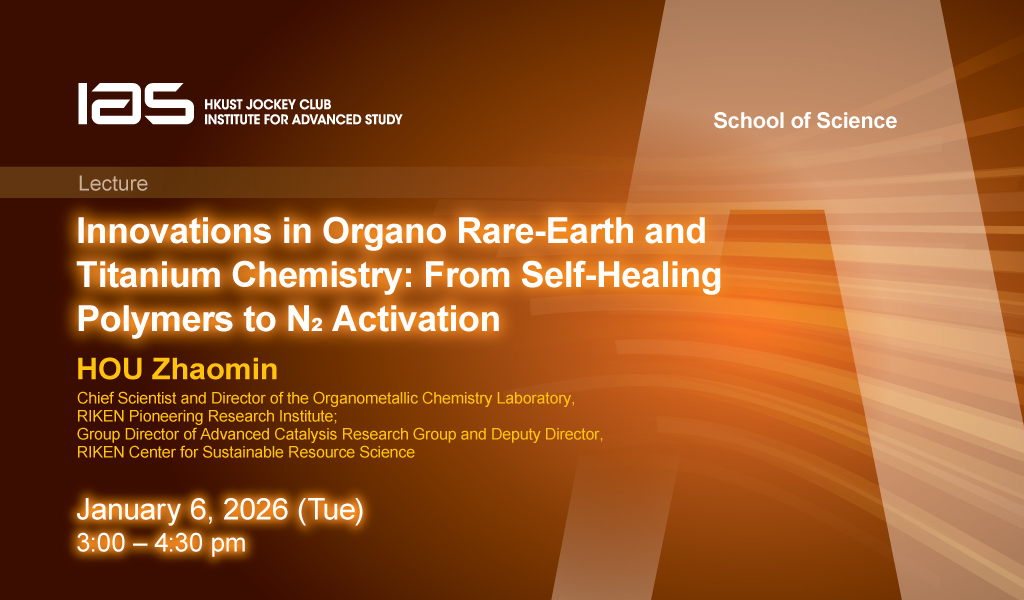更多科大概覽
Speaker: Professor Maojie ZHANG
Institution: College of Chemistry, Chemical Engineering and Materials Science, Soochow University
Hosted by: Professor Henry He YAN
Abstract
In this work, a novel narrow-bandgap conjugated polymer acceptor (PN1) based on electron-withdrawing 3,9-bis(2-methylene-(3-(1,1-dicyanomethylene)-indanone))-5,5,11,11-tetrakis[3-((2-hexyldecyl)oxy)benzene]-dithieno[2,3-d:2 ',3 '-d ']-s-indaceno[1,2-b:5,6-b ']dithiophene as the core building block and thiophene as the linking unit was developed and applied in all-polymer solar cells (all-PSCs). The PN1 exhibits a broad and strong absorption in the region of 550-800 nm with a high maximum extinction coefficient of 1.28×105 cm-1, a high electron mobility of 9.39×10-4 cm2/V·s and more ordered molecular packing. In addition, it also possesses a relatively higher lowest unoccupied molecular orbital (LUMO) of -3.85 eV, which is beneficial to improve open circuit voltage (Voc) and reduce the energy loss of the device. By matching with the wide bandgap polymer donor PM6, the all-PSCs achieved a power conversion efficiency (PCE) of 10.5% with a large Voc of 1.0 V, a high short circuit current density (Jsc) of 15.2 mA/cm2 and a superior fill factor (FF) of 0.69. Our work demonstrated that PN1 is a promising polymer acceptor for application in all-PSCs.
About the speaker
Professor ZHANG has published over 120 papers with more than 6000 citations (h-index = 43). Developed multiple new design strategies for organic photovoltaic materials; fabricated high-performance polymer solar cells. Awards include: National Science Fund for Outstanding Young Scholars in 2014; Jiangsu province innovative and entrepreneurial talent in 2017; Web of science highly cited researcher in 2018.
Institution: College of Chemistry, Chemical Engineering and Materials Science, Soochow University
Hosted by: Professor Henry He YAN
Abstract
In this work, a novel narrow-bandgap conjugated polymer acceptor (PN1) based on electron-withdrawing 3,9-bis(2-methylene-(3-(1,1-dicyanomethylene)-indanone))-5,5,11,11-tetrakis[3-((2-hexyldecyl)oxy)benzene]-dithieno[2,3-d:2 ',3 '-d ']-s-indaceno[1,2-b:5,6-b ']dithiophene as the core building block and thiophene as the linking unit was developed and applied in all-polymer solar cells (all-PSCs). The PN1 exhibits a broad and strong absorption in the region of 550-800 nm with a high maximum extinction coefficient of 1.28×105 cm-1, a high electron mobility of 9.39×10-4 cm2/V·s and more ordered molecular packing. In addition, it also possesses a relatively higher lowest unoccupied molecular orbital (LUMO) of -3.85 eV, which is beneficial to improve open circuit voltage (Voc) and reduce the energy loss of the device. By matching with the wide bandgap polymer donor PM6, the all-PSCs achieved a power conversion efficiency (PCE) of 10.5% with a large Voc of 1.0 V, a high short circuit current density (Jsc) of 15.2 mA/cm2 and a superior fill factor (FF) of 0.69. Our work demonstrated that PN1 is a promising polymer acceptor for application in all-PSCs.
About the speaker
Professor ZHANG has published over 120 papers with more than 6000 citations (h-index = 43). Developed multiple new design strategies for organic photovoltaic materials; fabricated high-performance polymer solar cells. Awards include: National Science Fund for Outstanding Young Scholars in 2014; Jiangsu province innovative and entrepreneurial talent in 2017; Web of science highly cited researcher in 2018.
8月20日
10:30am - 11:00am

地點
Room 4504, 4/F (Lifts 25/26), Academic Building, HKUST
講者/表演者
主辦單位
Department of Chemistry
聯絡方法
chivy@ust.hk
付款詳情
對象
PG Students, Faculty and Staff
語言
英語
其他活動

1月6日
研討會, 演講, 講座
IAS / School of Science Joint Lecture - Innovations in Organo Rare-Earth and Titanium Chemistry: From Self-Healing Polymers to N2 Activation
Abstract
In this lecture, the speaker will introduce their recent studies on the development of innovative organometallic complexes and catalysts aimed at realizing unprecedented chemical trans...

12月5日
研討會, 演講, 講座
IAS / School of Science Joint Lecture - Human B Cell Receptor-Epitope Selection for Pan-Sarbecovirus Neutralization
Abstract
The induction of broadly neutralizing antibodies (bnAbs) against viruses requires the specific activation of human B cell receptors (BCRs) by viral epitopes. Following BCR activation, ...
